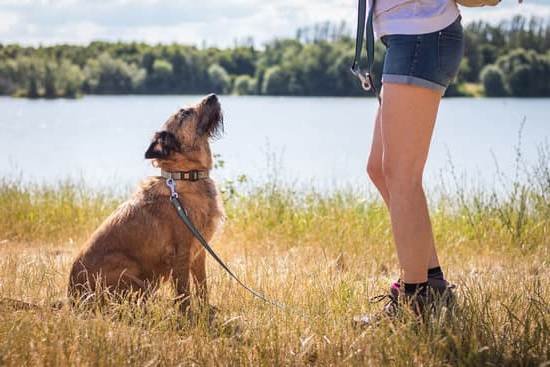Are you struggling with a restless and easily excitable pup? If so, you may be wondering how to train a dog to sit still. Teaching your furry companion to sit still can have numerous benefits, not only for their behavior but also for your own sanity. In this article, we will guide you through the process of training your dog to sit still, covering everything from understanding the importance of this command to troubleshooting common challenges.
Training your dog to sit still is not just about having a well-behaved pet; it can also improve their safety and wellbeing. Whether you’re at home, out for a walk, or at the vet’s office, having the ability to command your dog to sit still can prevent them from getting into potentially dangerous situations. Additionally, teaching them this skill can help reduce their anxiety and hyperactivity, leading to a happier and more contented canine companion.
Before diving into the nitty-gritty of training techniques and tools, it’s important to understand why teaching your dog to sit still is essential. This basic command forms the foundation for more advanced obedience training and allows you to establish yourself as the pack leader. By mastering the “sit” command, you set the stage for better communication and overall obedience from your four-legged friend.
Understanding the Importance of Teaching Your Dog to Sit Still
Building Self-Control and Discipline
Teaching your dog to sit still is not just about having a well-behaved pet. It also helps them develop self-control and discipline. When a dog learns to sit still on command, they are learning to control their impulses and behavior. This can be particularly useful in situations where your dog needs to calm down, such as when meeting new people or other pets.
Ensuring Safety
Another important reason for teaching your dog to sit still is for their own safety as well as the safety of others. A dog that can sit still on command is less likely to engage in behaviors that could put themselves or others at risk. For example, if your dog tends to jump on people when they come into your home, teaching them to sit still instead can prevent accidents and injuries.
Enhancing Communication
Training your dog to sit still also enhances communication between you and your pet. When you give the command for them to sit still, it establishes a clear line of communication about what behavior is expected from them. This ultimately strengthens the bond between you and your dog and makes it easier for them to understand what is required of them in various situations.
By understanding the importance of teaching your dog to sit still, you can effectively communicate with your pet and ensure their safety while also promoting self-control and discipline. Using positive reinforcement techniques will help make the training process enjoyable for both you and your furry friend.
Basic Commands
Teaching your dog to sit still is one of the most fundamental and essential commands you can teach them. This basic command not only helps to keep your dog under control in various situations, but it also forms the foundation for more advanced training.
The sit command can prevent your dog from jumping on people, running into the street, or behaving aggressively towards other animals. It also provides mental stimulation for your dog and strengthens the bond between you and your furry friend.
When teaching your dog to sit still, it’s important to be patient and consistent. Start by holding a treat close to your dog’s nose and then slowly raise it above their head. As their head goes up, their bottom will naturally go down. Once they are in the sitting position, praise them and give them the treat. Repeat this process several times a day until your dog can sit on command without needing a treat every time.
This positive feedback encourages your dog to repeat the desired behavior. Consistency is key when training a dog to sit still, so be sure to use these reinforcement techniques every time you practice the command with your furry companion.
Training a dog to sit still may come with some challenges. It’s common for dogs to get distracted during training sessions or to have difficulty mastering the command in certain environments. However, by following these techniques and being patient with your furry friend, you can overcome these challenges and successfully teach your dog to sit still in any situation.
Tools and Equipment for Training Your Dog to Sit Still
Training a dog to sit still requires the right tools and equipment to ensure a successful training process. Here are some essential items you will need:
- Collar and Leash: A good-quality collar and leash are essential for controlling your dog during training sessions. Make sure the collar fits comfortably and securely, and choose a leash that gives you enough control without being too restrictive.
- Treats: High-value treats are an important tool for positive reinforcement when teaching your dog to sit still. Choose treats that your dog loves and responds well to, as these will be key in motivating them to follow your commands.
- Clicker: A clicker can be a useful tool for marking the precise moment your dog performs the desired behavior, in this case, sitting still. This can help reinforce the behavior and communicate clearly with your dog during training sessions.
- Training Mat or Rug: Having a designated training area, such as a mat or rug, can help create a consistent environment for your dog to associate with learning the sit still command. It provides a clear boundary for where training takes place and can aid in minimizing distractions.
It’s important to ensure that any tools or equipment used during the training process are safe and appropriate for your dog’s size, breed, and temperament. Using these tools effectively can make the process of teaching your dog to sit still much smoother and more successful.
Positive Reinforcement Techniques for Teaching Sit Still
Teaching your dog to sit still is an essential skill that can benefit both you and your furry friend. By mastering the art of sitting still, your dog can become better behaved, calmer, and more obedient. In this section, we will explore some positive reinforcement techniques that can help you effectively teach your dog to sit still.
To begin teaching your dog to sit still, it’s important to understand the concept of positive reinforcement. This training method involves rewarding your dog for displaying the desired behavior, in this case, sitting still. Positive reinforcement can be achieved through various means such as treats, praise, or toys. The key is to find what motivates your dog and use it as a reward for sitting still.
Here are some positive reinforcement techniques for teaching sit still:
- Using treats: When starting to train your dog to sit still, hold a treat in front of their nose and slowly move it upwards while giving the command “sit”. As their head follows the treat, their bottom will naturally lower into a sitting position. Once they are sitting still, reward them with the treat and verbal praise.
- Verbal praise: Dogs respond well to verbal cues and praise. Whenever your dog successfully sits still on command, make sure to offer enthusiastic verbal praise such as “good job” or “well done.” This positive feedback reinforces the behavior and encourages them to continue sitting still.
- Toys: For some dogs, a favorite toy can be just as motivating as treats. Use their favorite toy as a reward for sitting still on command. After they successfully follow the command, engage in playtime with them using their favorite toy as a reward.
By implementing these positive reinforcement techniques consistently and patiently, you can effectively train your dog to sit still in various situations both at home and outside. Remember that every dog responds differently so it’s important to stay patient and tailor your training methods accordingly.
Common Mistakes to Avoid When Training Your Dog to Sit Still
When training your dog to sit still, it is important to be aware of some common mistakes that can hinder the training process. One common mistake is not being consistent with the command or the timing of the reward.
Dogs thrive on consistency, so if you are not using the same command each time or if you are rewarding at different times, your dog may become confused and not understand what is expected of them. It is important to use the same verbal command each time, such as “sit,” and to reward your dog immediately after they have successfully followed the command.
Another mistake to avoid is using punishment or negative reinforcement when training your dog to sit still. This can make the training process stressful for your dog and can lead to anxiety or fear around training sessions. Instead, focus on using positive reinforcement techniques such as treats, praise, and petting to encourage your dog to sit still. This will create a positive association with the behavior and make it more likely that they will repeat it in the future.
In addition, one mistake that many dog owners make when training their pets is expecting too much too soon. It’s important to remember that learning takes time and patience, especially for dogs who may have varying levels of energy and attention spans. Be patient with your dog and practice the sit command regularly in short sessions rather than expecting them to sit still for long periods right away.
| Common Mistakes | Avoidance Tips |
|---|---|
| Inconsistent commands and rewards | Use the same verbal command each time; Reward immediately after successful completion |
| Using punishment or negative reinforcement | Focus on positive reinforcement techniques such as treats, praise, and petting |
| Expecting too much too soon | Be patient; Practice in short sessions rather than expecting long periods of sitting still immediately |
Real-Life Situations
Teaching your dog to sit still is not just about getting them to stay in one place on command. It also involves preparing them for real-life situations where they will need to remain calm and composed.
One common scenario where the sit still command is essential is during vet visits. Many dogs feel anxious or scared when visiting the vet, and teaching them to sit still can help them stay calm and make the experience less stressful for both you and your pet.
Another real-life situation where the sit still command comes in handy is when you have visitors at home. Some dogs get overly excited or agitated when guests arrive, jumping on them or running around uncontrollably. By training your dog to sit still, you can ensure that they greet guests politely and do not cause any inconvenience or discomfort.
Additionally, the sit still command is crucial for outdoor activities such as picnics or outdoor dining at restaurants. If you enjoy spending time outdoors with your dog, teaching them to sit still will allow you to relax and enjoy your surroundings without worrying about your pet getting into trouble or bothering other people.
These real-life applications emphasize the importance of incorporating the sit still command into your dog’s training routine. Use positive reinforcement techniques and consistency to reinforce this behavior in various situations, ensuring that your furry friend remains well-behaved in any setting.
Troubleshooting
In conclusion, training your dog to sit still is a valuable skill that can benefit both you and your furry friend in numerous ways. Not only does it promote obedience and discipline, but it also lays the foundation for further training and creates a stronger bond between you and your pet. By understanding the importance of teaching your dog to sit still and mastering the sit command, you can set the stage for successful training sessions.
One of the key factors in training your dog to sit still is using positive reinforcement techniques. This involves rewarding your dog with treats, praise, or toys when they successfully execute the sit command. By consistently using positive reinforcement, you can create a strong association in your dog’s mind between sitting still and receiving rewards, making them more likely to comply with the command.
While there may be challenges along the way, it’s important to remain patient and persistent when training your dog to sit still. By avoiding common mistakes such as inconsistency or using forceful methods, and by being prepared to troubleshoot any issues that may arise, you can effectively train your dog to sit still. With dedication and the right approach, you will be able to enjoy the benefits of a well-behaved, obedient canine companion.
Frequently Asked Questions
How Do You Train a Dog That Won’t Sit Still?
Training a dog that won’t sit still can be challenging, but it’s important to start by teaching basic obedience commands. Using positive reinforcement techniques, such as offering treats and praise, can help encourage the dog to stay focused during training sessions.
How Do I Teach My Dog to Stay Still?
Teaching a dog to stay still requires patience and consistency. Start by practicing the “stay” command in a quiet and familiar environment, gradually increasing the duration as the dog becomes more comfortable with the concept. Using verbal cues and hand signals can also aid in reinforcing the behavior.
What Are 3 Effective Ways to Train a Dog to Sit?
Three effective ways to train a dog to sit include using luring techniques with treats or toys, capturing the behavior by rewarding the dog whenever they naturally sit, and shaping the behavior through successive approximations. Consistency, patience, and positive reinforcement are key elements in successful training.

Welcome to the blog! I am a professional dog trainer and have been working with dogs for many years. In this blog, I will be discussing various topics related to dog training, including tips, tricks, and advice. I hope you find this information helpful and informative. Thanks for reading!





